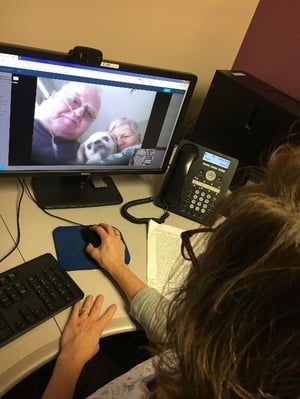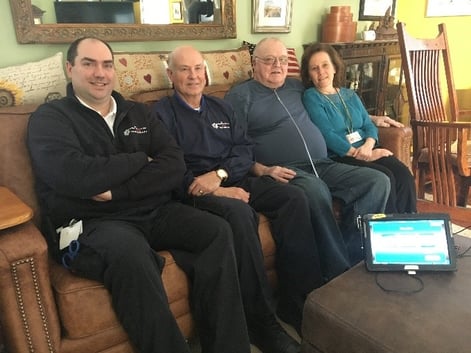Anne Carle, RN, Telehealth Clinical Coordinator at Cornerstone VNA shared with HRS a wonderful patient success story. In her own words, read her story below about caring for George Robinson, a patient who was able to manage COPD with the use of telehealth.
I want to share an amazing story of a patient, George Robinson, who rose above his chronic disease and improved his quality of life with the utilization of telehealth in the home.
Here is George’s story.
Managing COPD Before Telehealth: ED Readmissions & COPD Exacerbation
George is a 73 year old gentleman who was admitted to Cornerstone VNA in August 2017 after being discharged from the hospital with a diagnosis of Chronic Obstructive Pulmonary Disease (COPD) and Congestive Heart Failure (CHF). George required the use of oxygen continuously at 4 liters during the day and 5 liters during the night. Upon initial evaluation, our Palliative Care (PC) Nurse stated, “when we first met, he was extremely weak, exhausted easily with activity, felt anxious at times, and was short of breath (with minimal excursion) to a point that even speaking was an effort.” Our PC Nurse added, “the patient expressed how down in the dumps he was about his decline and how it affected his life.”
Shortly after his admission to Cornerstone VNA Home Care, George went back to the Emergency Department for COPD exacerbation. George was treated, released, and sent home. Cornerstone VNA services resumed and George continued to be followed by a Palliative Care (PC) Nurse. The PC Nurse set small goals for George and he began to show some improvements and gained confidence that he could get better. Once George showed improved strength, and was not so overwhelmed due to his chronic condition, the PC Nurse felt that George was ready to transition to the telehealth program.
Improved Patient Education with Telehealth
As the Clinical Coordinator for telehealth, I received the telehealth referral and coordinated with the PC Nurse to install the telehealth unit in George’s home. Cornerstone VNA uses Health Recovery Solutions (HRS)' software, which is loaded on 4G Samsung tablets. The tablets are paired through Bluetooth technology with a wireless blood pressure cuff machine, a pulse ox machine (to measure oxygen and heart rate), and a scale for daily weights.
Our PC Nurse educated the patient on the use of the equipment and instructed George on the special educational features available through the software on the tablet, which includes educational reading material and educational videos specific to George’s chronic diseases. The PC Nurse also explained to George how to answer daily survey questions on how he was feeling, and the value of the video chat capabilities.
George was very receptive to the program and faithfully completed his vital signs, weights, and survey questions daily. I was able to monitor him closely on a daily basis from my office computer where I would study his vital signs and weights for any irregularities. I would call George to triage his condition (evaluate his symptoms), and if needed, I would schedule a nursing visit and alert his doctor and our PC Nurse with any changes in his condition.
If George had low oxygen reading, I would immediately connect with him on the telehealth video conferencing and conduct a visual assessment to make sure he was not in any respiratory distress. I would instruct/educate George on how to do relaxation breathing techniques to bring his O2 readings back up above 90%. Thanks to the video chat feature, I could also provide medication teaching if needed. I mainly focused on engaging George to utilize the educational videos on the telehealth unit to help him grasp a better understanding of his chronic diseases and how to better manage his symptoms.

Each day, George continued to show progress on learning how to better manage his symptoms and he began to gain more confidence. He was eventually able to verbalize and demonstrate that he was following his medication regimen on a daily basis, and followed the protocols of better managing his CHF and COPD symptoms.
George’s respiratory status improved, which allowed him to talk in clear sentences without feeling short of breath, and his activity levels started to increase. We were also able to decrease his oxygen to 4 liters, via nasal cannula, both day and night. Today, with the use of an Oxymizer Pendant (oxygen-conserving device), George is able to leave his home with his oxygen set at 3 liters.
George remained on our services until the end of November 2017. During his 4 months with Cornerstone VNA, George had only one emergency room visit and no re-hospitalizations.
Chronic Care Management with Telehealth
Although George was discharged from Cornerstone VNA and was showing signs of improvement, his PC Nurse and I still felt it was important that George continue to be closely monitored, particularly due to his chronic conditions.
Thanks to a unique partnership with Frisbie Memorial Hospital’s (FMH) Mobile Integrated Health (MIH) Paramedicine Program, George was able to continue with telehealth in the home.

This grant funded program by the Cardinal Health Foundation was established to support patients in the community who have a chronic respiratory illness and do not qualify for home care services, but need to be monitored with the use of telehealth. As the Clinical Coordinator for telehealth, I collaborate with the FMH Paramedics who send referrals for patients in the community in need of remote monitoring. I assist with the installment of the telehealth equipment and managing those patients in partnership with the MIH Paramedics.
During the two months that George has been on the MIH program, he has not had to visit the emergency room nor has he been re-hospitalized. George continues to remain stable with the use of telehealth in the home, and he receives well-check visits from the FMH MIH Paramedics every 2 weeks, or more frequently if needed. George understands and recognizes the symptoms of his CHF/COPD and when it’s appropriate to notify his primary care physician.
Recently I had the pleasure of meeting George in his home and his supportive wife, Winnona, who is very involved in his care, along with their lovely dog, Pepper. I was accompanied by two of the FMH MIH Paramedics, and a Cornerstone VNA co-worker. As a telehealth nurse, it was a pleasure to hear George talk about how he has regained his health and feels like he has his quality of life back again. It has been very rewarding to be a part of this journey with him.
In George’s own words:
“I find that the Telehealth makes me feel more secure that I am doing the right thing. My anxiety is less and it helps to know there is someone there to help if I need it. It makes my life a lot better, I am able to cope better, and it keeps me on the right track. The education videos are very good. They have helped me understand things better. I have a better outlook on life and am more satisfied with ‘what I can do’ rather than ‘what I can’t do’. Being a chronic patient I am very grateful for this service.”
- George Robinson
George is a true inspiration to other patients that are facing chronic diseases on a daily basis.
Written by Anne Carle, RN, Telehealth Clinical Manager